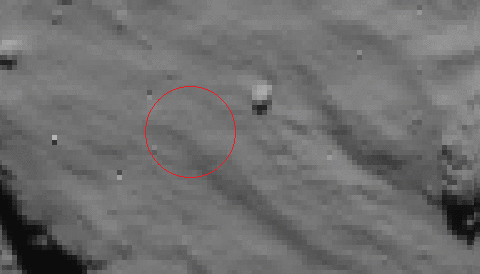Two images zero in on the spot where Philae touched down — and then bounced away — on the surface of Comet 67P/Churyumov-Gerasimenko. The landing occurred precisely where it should have, but a pair of anchoring harpoons failed to activate. ESA / OSIRIS team
With its battery power failing, Philae became the “little lander than could” and managed to return results from all 10 of its science instruments before slipping into hibernation.
If everything had gone according to a carefully constructed plan, the European Space Agency’s Philae spacecraft would have descended from mother ship Rosetta, dropped onto its flat, wide-open landing site on Comet 67P/Churymov-Gerasimenko, relayed a rush of findings about the comet’s structure and composition, and then basked in enough sunlight to continue operating for several weeks.
But space exploration is never easy, as engineers and scientists at ESA’s control center in Darmstadt, Germany, learned this week.
Troubles began when Wednesday when the lander made a pinpoint landing on Agilkia, the Sun-drenched landing site on the “head” of the twin-lobed comet. But two systems designed to anchor the craft in the ultra-low gravity — a downward-pushing thruster and two harpoons — both failed. As a result, Philae bounced not once but twice, coming to rest hundreds of meters from its intended location.
Initial images returned to Earth showed the lander wedged in rugged terrain and deep in shadow from a nearby cliff, its legs angled awkwardly and canted some 30° from horizontal. And yet, the lander was undamaged by by this roller-coaster arrival, ending up with its radio antenna pointed skyward.
etting Philae to perform as planned immediately became a race against time, made more intense because the windows of contact with Rosetta were intermittent. The lander’s initial surface contact automatically triggered the start of data-gathering activities — yet for the next two hours Philae was airborne, making a 1-km-high arc above the nucleus. And the final, precarious perch made it risky to deploy the lander’s mechanical probe, X-ray spectrometer, and sampling drill.
Worse, the clock was ticking. Philae was designed to complete its primary activities within 64 hours, using only the power from an on-board battery. Extended operations could follow if small solar-cell panels provided enough power. But the cliff’s deep shadow exposed the landed only to 1½ hours of sunlight during the comet’s 12.4-hour rotation, and some panels were pointed toward the cliff.

